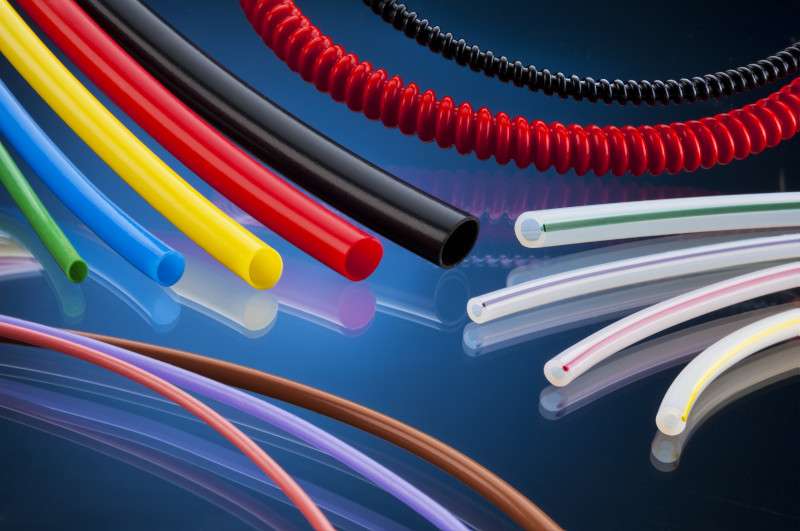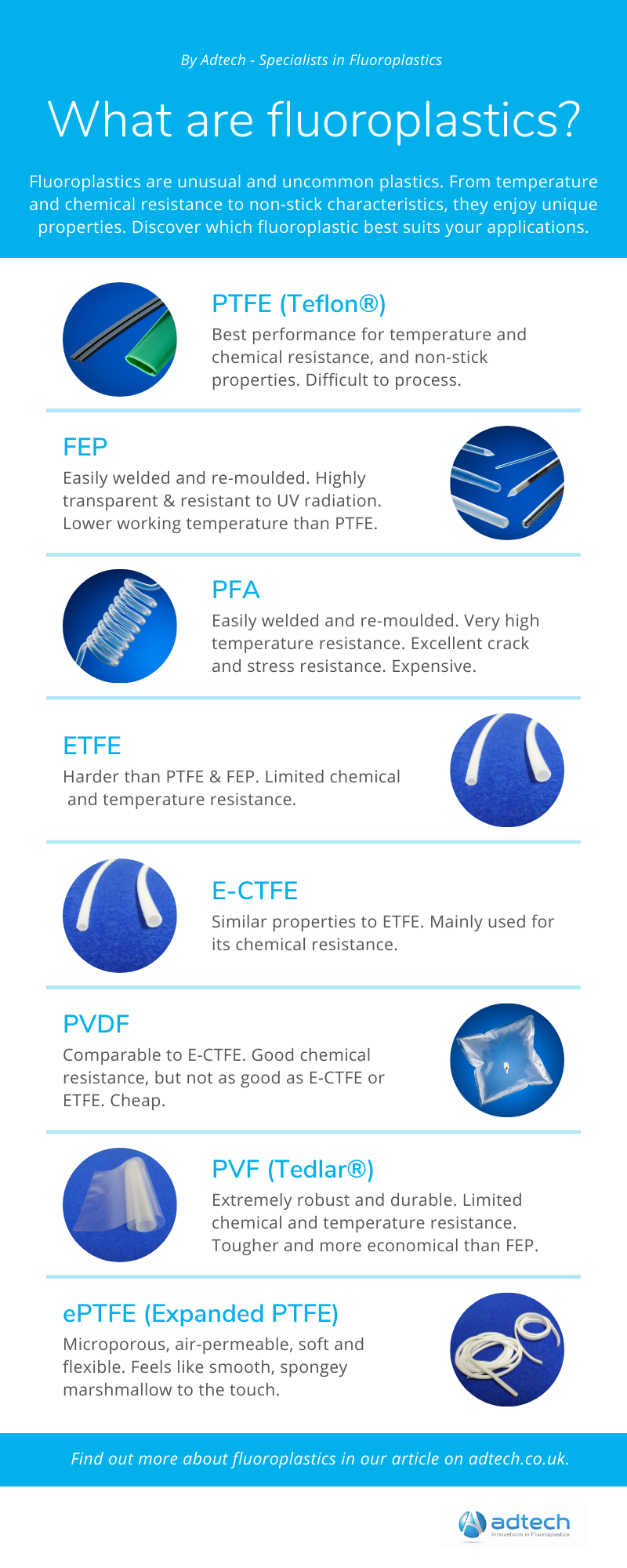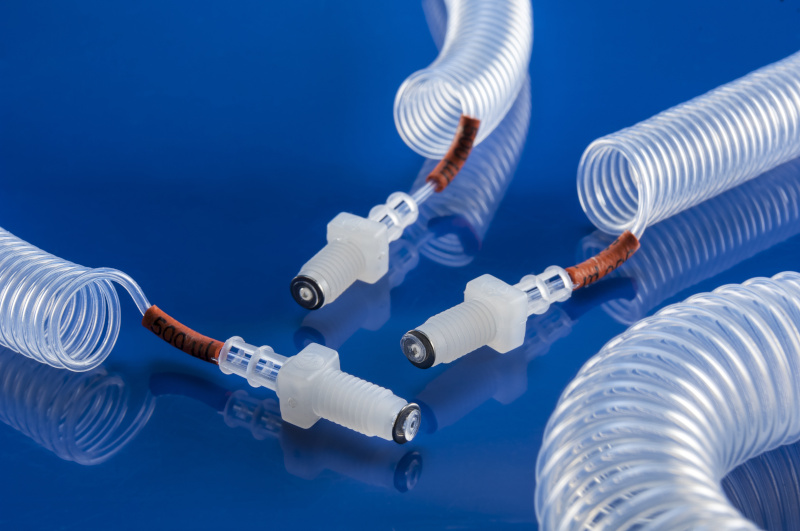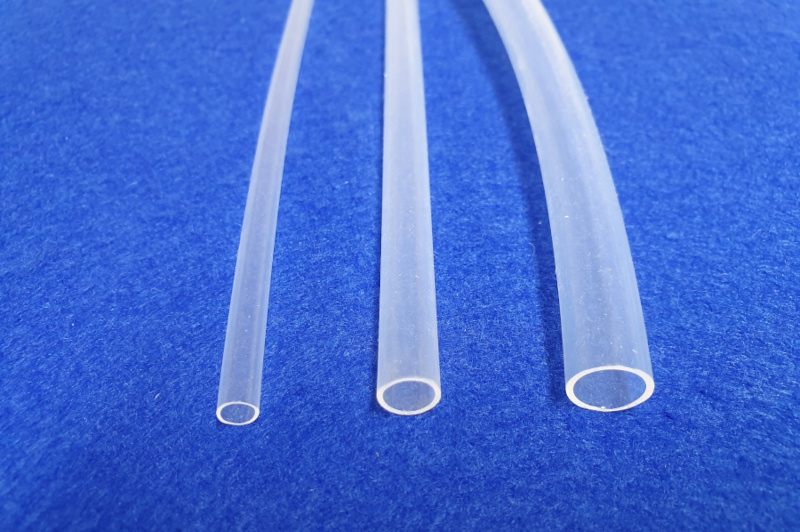What are fluoroplastics? A simple guide

Fluoroplastics are unusual and very uncommon plastics. Discover why fluoropolymers are such unique materials, and which fluoroplastic is best suited to your application.
The unique properties of fluoroplastics
Fluoroplastics is a clumsy word given to a group of plastics where the molecules consist of a carbon chain with fluorine atoms attached. These fluorine atoms dramatically change the properties of the material, and give fluoropolymers special properties.
-
Very high working temperatures
-
Non-stick characteristics and low friction surface
-
Total resistance to chemical and solvents
-
Very high electrical resistance
-
Resistance to weather, UV light and corrosion
-
Inert, non-toxic and bio-compatible
Applications for fluoropolymers
The unique properties of fluoroplastics make them high performance materials with limitless possibilities. As a result, PTFE, FEP and PFA can meet severe environmental conditions and are ideal for use in many medical, food and drink, automotive, oil and gas, and other applications.
The combination of low friction and temperature resistance allows fluoropolymers to be used in applications such as sleeve bearings, push-pull cables and non-stick roller covers. Virtually total chemical resistance at temperatures up to 260°C means PTFE, FEP and PFA can handle the transport of all fluid chemicals and solvents.
Fluoroplastics can also be used to protect less resistant materials, such as glass, stainless steel on stirrers, thermometers, probes and vat heaters. Due to the excellent dielectric and other properties combined, PTFE and FEP find many unique applications in electric and electronic engineering, such as insulation of miniature components and connections in hot environments.
Inert, non-toxic and bio-compatible properties are sought after by medical device manufacturers for applications such as intravenous catheters, catheter introducers and angiographic catheters. Fluoropolymers are also ideal for day-to-day applications and everyday uses, from ski bindings to waterproof jackets.
The different fluoroplastic materials
The more common members of the fluoroplastics family are:

PTFE (PolyTetraFluoroEthylene)
Also known as Teflon®, PTFE is the grandfather of all fluoroplastics; it is the most unusual and exhibits the best performance in terms of temperature and chemical resistance, and non-stick properties. Compared with similar fluoropolymers, PTFE usually has the best price : performance ratio.
The main disadvantage of PTFE is that it does not actually melt when heated and is therefore difficult to process. Very unconventional techniques are needed to mould, extrude and weld this fluoropolymer.
Due to its unique properties, PTFE is ideal for applications in electrical insulation and the protection of electronic components. PTFE is also widely used in high temperature applications, from fire critical applications to terminal insulation on heating elements and jet engines, and external aircraft fittings.
FEP (FluoroEthylenePropylene)
FEP was developed as a ‘‘melt processable’’ version of PTFE. That is, it can be processed by normal plastic methods and can easily be welded and re-moulded. FEP has very similar properties to PTFE, but has a lower maximum operating temperature of +200°C instead of +260°C. FEP is also highly transparent and resistant to UV radiation.
FEP is widely used for laboratory applications that involves critical or highly corrosive processes. Other applications include auto sampling, chromatography, medical devices, UVC sterilisation equipment, insulation of high temperature cables and encapsulation of sensitive electrical components.
PFA (PerFluorAlkoxy)
PFA was developed as a high temperature version of FEP - it has similar properties, but it can be used at temperatures up to +260°C. PFA is a melt-processable fluoropolymer which can be injected, compressed and transfer moulded.
PFA has similar physical and chemical properties to PTFE, but it has 10 times the flex life and less permeation. PFA has an outstanding crack and stress resistance and a low coefficient friction. The main disadvantage of PFA is that it is more expensive than PTFE or FEP.
From medical tubing to heat exchangers, semi-conductor baskets, pumps and fittings, and valve liners, PFA is widely used in applications that require a higher purity grade, excellent chemical resistance and a high working temperature.
ETFE (Ethylene Tetra Fluoro Ethylene Copolymer)
ETFE is a normal thermoplastic, but it is much harder than PTFE & FEP and similar in hardness to nylon – It is therefore used as an ‘‘Engineering Plastic’’. The improvement in stiffness is paid for by reduced chemical resistance and working temperature.
E-CTFE (Ethylene-Chloro Tri Fluoro Ethylene)
Used mainly for its chemical resistance, E-CTFE is a tough fluoroplastic with similar properties to ETFE.
PVDF (Poly Vinylidene Fluoride)
PVDF is a very hard plastic roughly comparable to E-CTFE and relatively cheap compared with other fluoroplastics. PVDF has good chemical resistance, but not as good as E-CTFE or ETFE.
PVDF tubing is particularly easy to hand weld and used in conjunction with PVDF sheet can be used to fabricate chemical laboratory equipment.
PVF (Polyvinyl Fluoride)
Also known as Tedlar®, PVF is an extremely robust and durable fluoroplastic with limited chemical and temperature resistance. PVF is tougher and more economical than FEP. PVF is normally used as a film in gas bags used for vehicle emission testing, solar heating panels and printing circuit laminating.
MFA (Methyl Fluoroacetate)
MFA has similar chemical, electrical and temperature properties than PFA, but offers higher clarity, low haze values and high light and UV transmittance.
ePTFE (Expanded PolyTetraFluoroEthylene)
Expanded PTFE (ePTFE) is microporous so air-permeable, and is perfect for any applications that require a permeable PTFE tube. Being microporous, ePTFE is significantly different to conventional PTFE tubing – the material is air-permeable, soft and flexible, and feels somewhat like smooth, spongey marshmallow to the touch.
You can compare the properties of the different fluoroplastic materials in the Technical Properties Comparison Table for Fluoroplastics.
This information is very general and at Adtech we are very keen to discuss the properties of these materials and to select the best one for your application. There are many subtle differences in these plastics which, if chosen carefully, can give great price and performance benefits.
Here at Adtech, we are specialists in delivering innovative fluoropolymer solutions for your technical applications. Find out more about our Fluoroplastic Products.
Share this article:
Related News Articles



